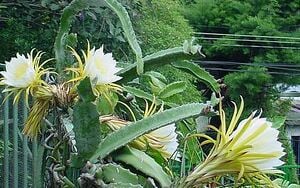
The pitaya or dragon fruit is a fairly easy to grow tropical to subtropical fruit in the cactus family, native to South and Central America. It needs to climb on a trellis, rocks or a large tree. Its three sided stem has rows of clusters of stubby spines on the stem ridges. The flowers are very large, white, aromatic and last only one day (Fig. 1). Although it is not of large commercial importance, it is fairly common throughout the world's tropics. It is well adapted to wet climates as long as its soil has good drainage.
There are at least 20 named varieties. One of the most common is the Costa Rican Pitaya. The fruit is dark purple both outside and inside. It is mildly sweet with an indistinct flavor. This is in the genus Hylocereus, as are most the commercial varieties. (Fig. 2) The flesh color varies greatly from dark purple to white to completely transparent.
The Yellow Dragon Fruit is especially prized (Fig.3) and is of the species Selenicereus megalanthus. Its flesh is clear transparent and very sweet. It seems to do very well grafted onto a Hylocereus pitaya root stock.
-
Fig.2 Pitaya Fruit
-
Fig.3 Yellow Dragon Fruit
These plants are not hard to start from seed but take an extra year or two to bearing that way. Some varieties must have genetically different plants present (started from seed) in order to set fruit.
Roy 19:56, 26 April 2006 (PDT)
External links
http://web.archive.org/web/20180315192541/http://www.tropicalfruitnursery.com:80/dragon/index.htm

